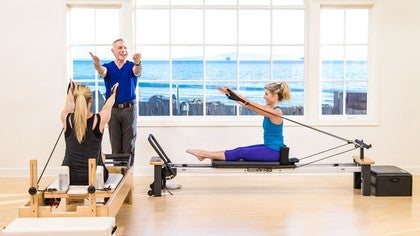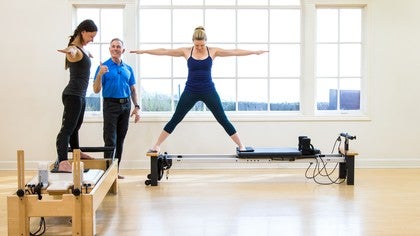Description
About This Video
Transcript
Read Full Transcript
We just finished a wonderful reformer class and intermediate level taught by Carrie Macy here and the two students that we had Lizanne and Giuliana typically work out on a balanced body reformer and we chose to use a Groth reformer. And we're going to talk just a little bit about some of the differences that they may have felt. Uh, one of the main ones was the, the foot work done on four springs, lowering the foot bar and then transitioning that into the 100. So Carrie, maybe first you can say, what in your training, why was that done? And then maybe we can get the response from the two students and how that felt for them. Well, footwork done on four springs, definitely just to start working the body and working the legs so that you get the connection from the legs right into the core right away. And there's a good sensation for that. Um, Laurie in the foot bar with your feet just helps for time saving measures. It also keeps you connected to what you just did and the footwork you were just set up into your symmetry and into your abdominals.
And then let's continue that so you don't have to sit up and break the flow. Right. And then, uh, that prepares you right away for the a hundred on four springs. We just leave it on four springs because again, it gets you right in there and gets you challenged. Um, and you know, continuing in that on the same path for you guys, how was that different in your body to do footwork from four to just go right into the 100 or Doosan coordination to get the foot bar down for sir, show me, let's show one of you. When can we show it with so much better? Yeah, I had to lie down. And then Carrie, can you refresh and just, absolutely, cause we don't do that on the balance body to, I don't think we usually sit up and turn it and change it. But yes, a different apparatus have of difference fit things up here to hold the foot bar in. So in this case, because it's a free foot bar, we are able to do this right. So Juliana would've just finished her foot work and from here she placed his one foot, so I'll use her right foot underneath the foot bar. The other foot comes down here on the inside and touches the little kickstand portion.
Then she lifts the foot bar just enough to be able to move the kickstand forward. And then she moves this foot so she doesn't get it caught and lowers the foot bar gently with her other foot and then flows right into. And then she reaches back and grabs her straps and here she goes, knees to chest, reach right out into her a hundred and there sh and she's going into it. Yes. Very nice. You don't have to do it. You just did your 200 maybe I'll go down here. Did.
So as far as effort wise, this, this reformer today versus what you may be more custom to use, what did it feel like for you? Did you feel well definitely the resistance is there. So much more resistance, but I think also having to lock into your core and other areas before you move and then really holding that all the way through. Yes was the difference. Yeah. Thanks. Awesome. I think another one, another noticeable piece maybe is the short box and long box set up seems to be a little different and I was kind of watching class so maybe will you grab the short box or the box and put it up on short and and carry. Can you talk about the setup for this and maybe Lizanne you have one last time. Okay. Yes.
So first let's lower the headrest and you can put the straps down on the floor. Yep. Okay. So the short box here for her height anyways, we'll come over the shoulder blocks and right in front of those little hooks. How would you determine that for someone? Ah, very good point though. Their leg length, really this generally most people fit with the short box in this position.
So I've covered the shoulder blocks and I'm right in front of the little hooks that the handles go on. If someone is much shorter, how tall are you? Yeah, so if someone's under five, three, um, you know, all five feet, then three. Okay. Then you might want to come forward in front of the shoulder blocks. That's just gonna be, you know, be closer to, to where we need to be. You want them to be seated so they have a little space back here.
And you also want, which I'll demonstrate in a moment, her feet to be able to be under the foot strap, but not touching this stuff. Yeah. Okay. So all right. So if she sits in the foot or sorry, in the, on the soapbox and her feet slip underneath, I'm going to look back here and she has a good amount of space about a hands with the distance back there, you can move back even a little bit more. And then the foot strap is going to come right up here at her ankles. Hard, flex her feet and she presses out on the strap so that the work of staying here and not slipping out of the strap comes actually from her own body and not from just her feet pressing into something up here. Um, or her toes holding on or something like that. And from your experience, just maybe on a different piece of equipment, did that feel a lot different or what is your normal setup? A lot more. Um, stabilization for sure.
You have to work those external rotators a lot and just holding it and keeping everything in line, keeping everything in place made a big difference. I'm really big difference. Awesome. Yeah. Thank you very much. Going can hop off and I think a third one, the short long box maybe. Ooh. Yeah, thanks. And that set up might be a little different too.
I think I'm okay on what you both have done. So we have one spring, which I think is pretty normal. And then go ahead and lie on your stomach where you normally would versus maybe a, okay. So her normal setup would be right with more of your chest off the box. Right? So I, um, I want you back so that your shoulders are actually flushed with the box a hocking come a little forward and now just tell us now, what does this feel?
How does this feel different? Even just before you hold the straps? Oh, the weight is a little farther back and have to work harder to lengthen my legs and really engaging my core. Right. Keep this position right. It's because your legs are heavy back here and there, they just sort of want to drop, right? So it's harder to, to stabilize that. So again, it's just the box is smaller as well. Length in general. So it's going to force you to work harder here and keep that continuous connection. Right. Um, and yeah, and then as pulling, pulling the straps is going to be, I'll just have him hold them, reach up as high as you can now on the leather and then keep your arms on the outside of the frame.
So she has to work hard to maintain this connection here and then she'll move her arms down to the ground from right under here and pull back. And again, we're still working to keep her belly off the box. Yes. And her legs long and return forward. So she's working back body and front body all together. Yeah. One of, I think what's, thank you for this quick demonstration and maybe a refresh your org, just a tune up for many of us.
But we have the opportunity and the advantage here to have growths, equipment and balanced body and peek every now and again or just different makers that come in. But I think it's important for all of us as teachers and movers to know how it feels different on different equipment because placement of our body is going to mean a little bit something different to us or as teachers teaching it what to look for. And maybe for people who are taking class, maybe they have this at home or in their home studio versus balanced body so they might or a different maker. So yeah, and I definitely agree with you. It's so important for instructors to be able to get on any piece of equipment, feel it in their body, and understand what they might have to change on a specific kind of equipment to feel what they want to feel. Cause it's all adoptable. I mean, that's what's so wonderful is we can get what we want out of anything. We just have to know what it should feel like to us and how we can create that. Yeah. Thank you, Carrie. Yeah. Thanks Roseanne. Thanks, Juliana.
Pilates at Home - Playlist 2: Reformer at Home
Comments
 Quick Question. First of all great segment. One of my clients just got a 89" Gratz reformer. Myself, my client, and her husband our still on an emotional high.
Quick Question. First of all great segment. One of my clients just got a 89" Gratz reformer. Myself, my client, and her husband our still on an emotional high.  I used to find doing "Hamstring Curls" very difficult on a Gratz during the eccentric phase of the hamstring curl because the resistance didn't feel the same same as it did on a Balanced Body. The carriage is kinda of slow to come back in. This is the case with Long Box Series (Pulling Straps and "T" Pull) taught on 1 spring. During the concentric phase of theses 2 exercises it feels great but during the eccentric phase the carriage takes forever to come in. I miss being in the same studio as you . You are such a great resource I am thankful for your work on Pilates Anytime.
I used to find doing "Hamstring Curls" very difficult on a Gratz during the eccentric phase of the hamstring curl because the resistance didn't feel the same same as it did on a Balanced Body. The carriage is kinda of slow to come back in. This is the case with Long Box Series (Pulling Straps and "T" Pull) taught on 1 spring. During the concentric phase of theses 2 exercises it feels great but during the eccentric phase the carriage takes forever to come in. I miss being in the same studio as you . You are such a great resource I am thankful for your work on Pilates Anytime. 
You need to be a subscriber to post a comment.
Please Log In or Create an Account to start your free trial.











